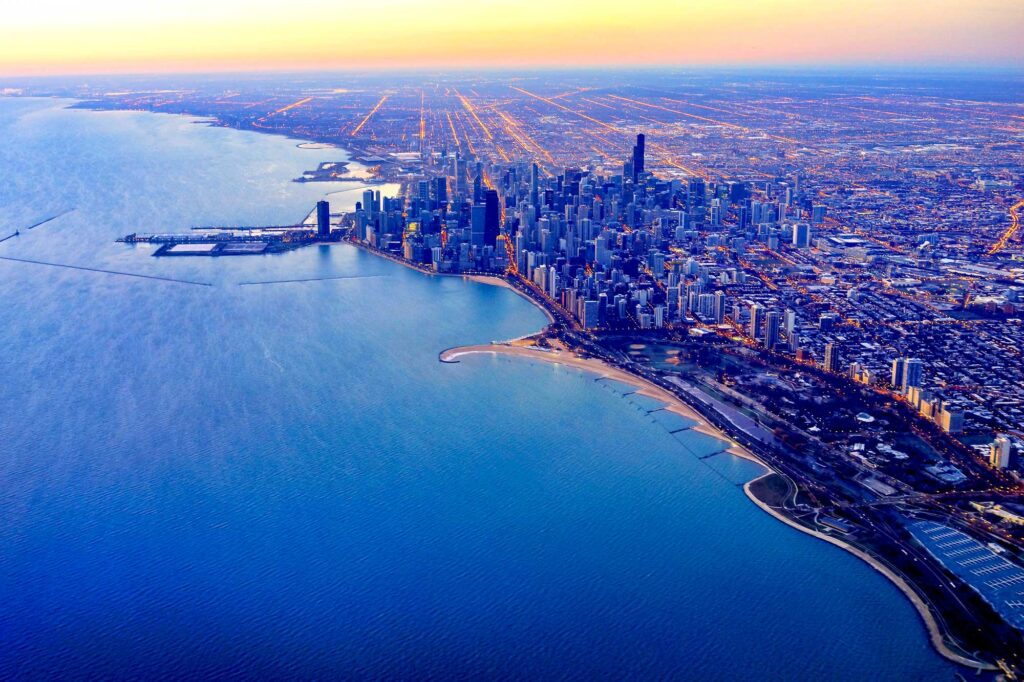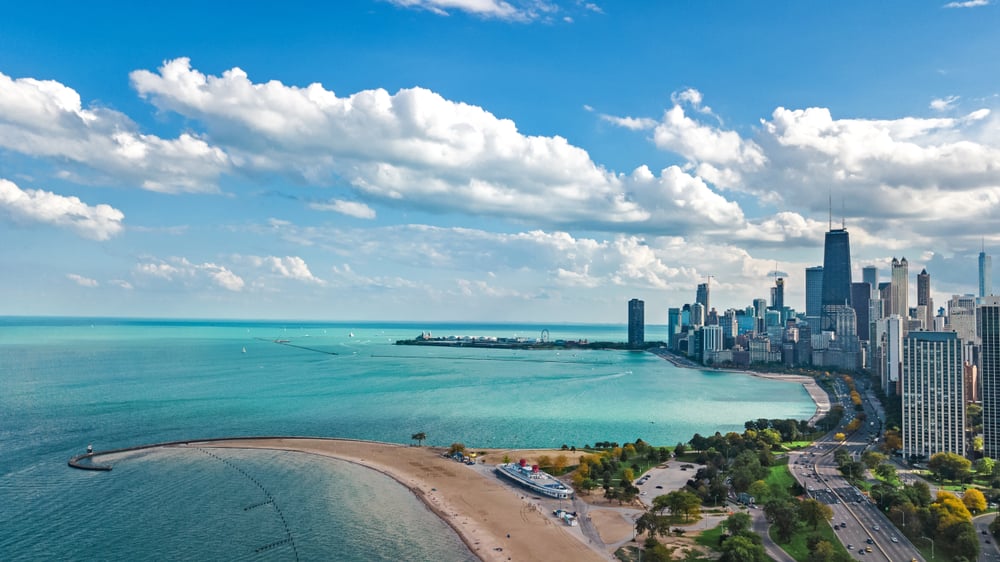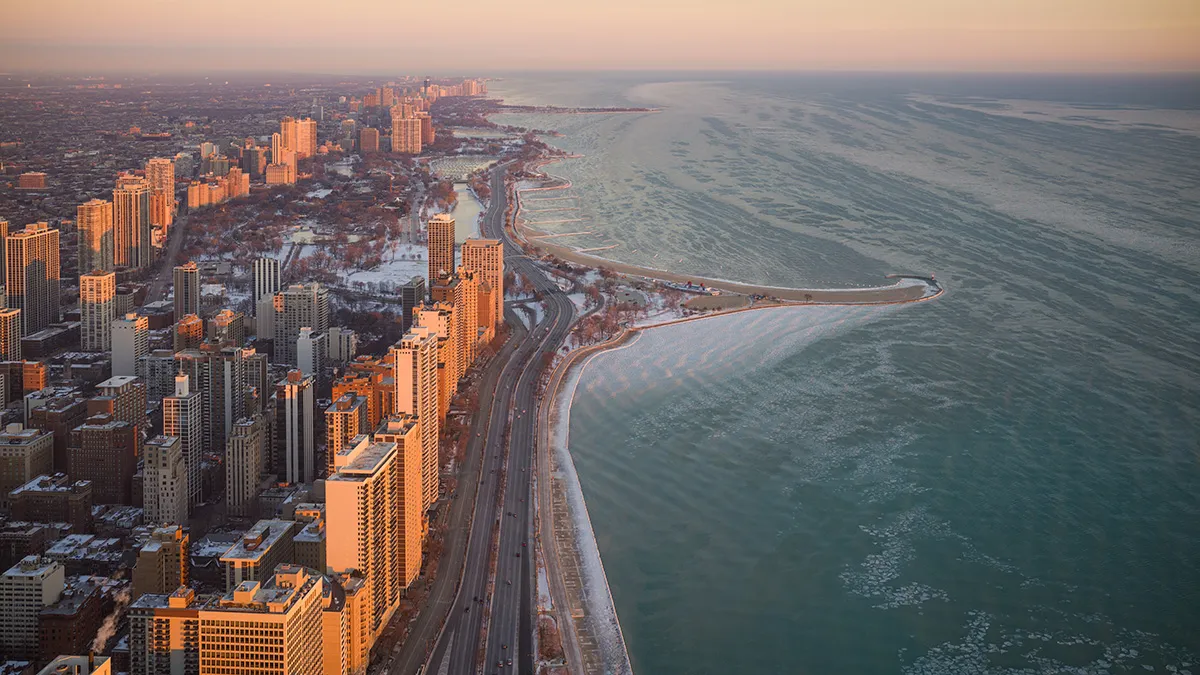No, Lake Michigan is not a saltwater lake; it is a freshwater lake. While it contains some dissolved substances, its salinity levels are relatively low compared to true saltwater bodies such as oceans.
Moreover, The salinity in Lake Michigan typically ranges between 50 to 500 parts per million (ppm), which is considerably lower than the average salinity of seawater, which is around 35,000 ppm. Therefore, Lake Michigan cannot be considered saltwater in the same sense as oceans.
So, let’s explore more about Michigan Lake!
Exploring Lake Michigan: A Snapshot of Its Rich History and Significance
The second-largest Great Lake, covering more than 22,000 square miles and bordering the states of Michigan, Wisconsin, Illinois, and Indiana, is totally contained inside the borders of the United States. It’s a crucial part of the regional economy, providing a home for various fish species, supporting tourism, and supplying fresh water to millions.
Moreover, the lake has a rich history shaped by glaciers, storms, and waves over thousands of years. It’s unique as the only Great Lake fully located in the U.S. The word “Michigan” comes from the Ojibwe language, meaning “great water.”
In its early history, Native American cultures like the Hopewell inhabited the region. European explorers, starting with Jean Nicolet in the 17th century, began interacting with the local tribes. The fur trade, wars, and European colonization influenced the area around Lake Michigan.
Further, it played a vital role in trade routes, connecting the Saint Lawrence River to the Mississippi River and the Gulf of Mexico. During the 19th century, it was integral to the growth of cities like Chicago, facilitating the transport of goods.
In terms of exploration, the lake’s bottom was first reached by J. Val Klump in 1985, and interesting underwater formations, possibly indicating ancient shorelines, have been discovered.
Recently, concerns have been raised about the warming of Lake Michigan, with steady increases in surface temperatures since 1980. This trend could impact the lake’s ecosystem and the survival of native species, including game fish.
Lake Michigan’s Hydrological Marvels

Subaquatic Topography: Beneath the serene surface it lies the Milwaukee Reef, an underwater formation stretching from Milwaukee to Racine and further between Grand Haven and Muskegon. This geological marvel serves as the divide, orchestrating the lake into northern and southern basins. These basins boast a clockwise water flow influenced by a symphony of factors – river currents, prevailing winds, and the Coriolis effect.
Temperature Disparities and Wind Dynamics: Westerly winds play a pivotal role, gently nudging surface waters eastward and imprinting a moderating influence on western Michigan’s climate. This dynamic interplay manifests in a notable 5 to 10 degrees Fahrenheit (2 to 5 degrees Celsius) difference in summer water temperatures between Wisconsin and Michigan shores.
Hydrological Unity of Michigan and Huron: Hydrologically, Michigan and Huron are a contiguous water expanse, collectively known as Lake Michigan–Huron. Despite this hydrological unity, they are typically treated as distinct bodies of water, with the Mackinac Bridge serving as the symbolic boundary. The intricate dance of water between Lake Superior, Lake Huron, and Lake Michigan is orchestrated by the bi-national Lake Superior Board of Control.
Statistics Unveiled: In addition, it is the largest entirely U.S.-contained Great Lake, and boasts a surface area of 22,404 sq mi (58,030 km2). Its sheer magnitude places it as the fifth-largest lake globally.
With dimensions of 307 miles (494 km) in length, 118 miles (190 km) in width, and a shoreline stretching 1,640 miles (2,640 km), Lake Michigan captures the imagination with its grandeur. The average depth reaches 46 fathoms 3 feet (279 ft; 85 m), while its deepest abyss plunges to 153 fathoms 5 feet (923 ft; 281 m).
Island Oases: Adding intrigue to Lake Michigan are its islands, with Beaver Island claiming the title of the largest at 55.8 sq mi (145 km2). From the Fox Islands and Manitou Islands in Leelanau County to the archipelago in Charlevoix County, each island contributes to the lake’s diverse tapestry.
Water Connections and Shipping Realities: The mid-20th-century developments of the Saint Lawrence Seaway and Great Lakes Waterway brought ocean vessels to the Great Lakes. However, the locks’ limitations hinder larger container ships. Lake freighters navigate the lakes, occasionally interrupted by winter ice. The Illinois Waterway connects Lake Michigan to the Gulf of Mexico, facilitating heavy commercial traffic, while pleasure boats find passage through the Erie Canal and Hudson River.
Water Level Fluctuations: It’s water levels oscillate seasonally, with the highest levels in summer and the lowest in winter. Notably, the lake experienced an unprecedented low in January 2013, reaching 29 inches below the long-term average. Since then, levels have rebounded, surpassing historical records.
Preserving the Liquid Lifeline: lastly, its Great Lakes counterparts, is a vital source of drinking water for millions. Governed collectively by the Conference of Great Lakes and St. Lawrence Governors and Premiers, the lake faces environmental challenges, including industrial operations along its shores. Vigilance is crucial to ensure the lake’s continued role as a pristine water source.
Lake Michigan’s Stunning Beachscapes
Breathtaking Views from Indiana Dunes National Park: Behold the beauty of Lake Michigan’s numerous beaches, making this region often referred to as the “Third Coast” of the United States, standing proudly alongside the Atlantic and Pacific Oceans. The soft, off-white sand, known as “singing sands” due to its high quartz content, emits a unique squeaking noise when walked upon.
Diverse Coastal Features: The eastern shore boasts the world’s largest freshwater dune system, where dunes rise several hundred feet above the lake surface. From Indiana Dunes National Park to Saugatuck Dunes State Park, and Warren Dunes State Park to Sleeping Bear Dunes National Lakeshore, these formations captivate visitors with their expansive and unique characteristics.
Temperature and Wind Dynamics: It’s water remains clear and cool, with temperatures ranging between 55 and 80 °F (13 and 27 °C), even in late summer. Prevailing westerly winds contribute to a flow of warmer water toward the Michigan shore during the summer months.
Varied Beach Landscapes: The western and northernmost beaches often feature a mix of rocks and sandy shores, while the southern and eastern stretches are typically sandy and dune-covered. Winter brings thick layers of ice to the eastern shore, shaped by prevailing westerly winds. Chicago’s lakefront, developed for parks and marinas, spans 24 miles along the lake, providing a picturesque backdrop.
Lakeside Cities and Their Charms: The Lake Michigan basin is home to twelve million people, with vibrant cities dotting its shores. From the iconic skyline of Chicago to the industrial prowess near Gary, Indiana, and the scenic beauty of Traverse City, each city along the coast contributes to the dynamic tapestry of the region.
Parks and Protected Areas: The National Park Service safeguards treasures like the Sleeping Bear Dunes National Lakeshore and Indiana Dunes National Park. The Hiawatha and Manistee National Forests, along with the Michigan Islands National Wildlife Refuge, contribute to the preservation of the shoreline’s natural wonders. State and local parks, such as Grand Haven State Park and Ludington State Park, offer additional havens for nature enthusiasts.
Discover Lake Michigan’s Charismatic Charm: Explore the Chicago Park District Beaches, revel in the serenity of Peninsula State Park, or immerse yourself in the pristine landscapes of Whitefish Dunes State Park. Its shores beckon, promising an unforgettable blend of natural beauty and human ingenuity.
Salinity in Lake Michigan: A Simple Overview
Understanding Salinity: It refers to the amount of salt in water and is measured in parts per thousand (ppt). Lake Michigan, although not a true saltwater body like oceans, contains some dissolved substances, resulting in relatively low levels.
Lake Michigan’s Salinity Range: Typically, it’s fluctuates between 50 to 500 parts per million (ppm). This range is significantly lower than the average of seawater, which is around 35,000 ppm.
Factors Influencing Salinity:
- Lake Size:
- Larger lakes, like Lake Michigan, have more surface area, leading to increased evaporation and more dissolved minerals. However, it’s salinity remains low compared to oceans.
- Lake Depth:
- With an average depth of 279 feet and a maximum depth of 925 feet, its circulatory pattern and slow water movement make it challenging to freeze over. Also, varies with depth, with deeper water resembling ocean-like salinity.
- Freshwater Inflow:
- Lake Michigan is freshwater, and its salt content comes from the sea. Changes in freshwater inflow and water temperature throughout the year impact the lake water.
- Evaporation:
- Evaporation from it influences its salinity. A saltier lake experiences more evaporation, while a higher volume of freshwater reduces evaporation.
- Rainfall:
- The Great Lakes, including Lake Michigan, hold a substantial volume of water. Rainfall dilutes the salt content in the lake, affecting its overall pH
Impact on Residents:
- Residents of the Chicago metropolitan area rely on Lake Michigan for water, but specific details about the lake’s salt content in this context are not widely known.
Lake Michigan: A Tapestry of Activities

Abundant Fisheries and Ecological Challenges: Lake Michigan’s aquatic realm, once thriving with native species like lake whitefish and yellow perch, now grapples with the consequences of historical events and invasive species. Overharvesting, the introduction of sea lampreys, and improvements to the Welland Canal in 1918 triggered a decline in native lake trout populations.
To counterbalance, salmonids such as brown trout, steelhead, coho, and chinook salmon were introduced, leading to a vibrant sport fishery. However, it faces ongoing threats from invasive species like lampreys, round gobies, and mussels, altering its ecosystem and posing challenges to native fish populations.
Dynamic Fishing Industry: Additionally, its commercial fishery, managed by tribal and state-licensed entities, focuses on the prized lake whitefish. Despite fluctuations in annual harvests and market prices, the industry remains resilient. Sports fishing, a popular pursuit, targets diverse catches like salmon, whitefish, smelt, lake trout, and walleye. Its charter fishing industry burgeoned in the late 1960s, fueled by successful salmon stocking programs.
Vital Role in Shipping and Commerce: As part of the Great Lakes network, it serves as a crucial transport route for bulk goods. Iron ore, grain, and potash move across its waters, supporting industries such as steel. While liquid and containerized cargo is transported, the seaway’s lock limitations impact the passage of wider container vessels. Over the years, the total shipping volume on the lake has witnessed a decline. The Port of Chicago, a key hub along Lake Calumet, handles grain and bulk liquid storage.
Ferry Services and Nautical Adventures: Two iconic ferries, the historic SS Badger and the modern Lake Express, traverse Lake Michigan, connecting Wisconsin and Michigan. These vessels facilitate both passenger and vehicle transport, contributing to the lake’s maritime legacy. The SS Badger, with its daily operations between Manitowoc and Ludington, and the Lake Express, linking Milwaukee and Muskegon, offer scenic and efficient crossings.
Tourism and Recreation Hub: In the end, its shores buzz with tourism and recreational activities. From small cruise ships to sailing adventures, the lake attracts enthusiasts engaged in yachting, sea kayaking, diving, kitesurfing, and lake surfing. The Great Lakes Circle Tour, a scenic road system, weaves through all of the Great Lakes, inviting travelers to explore the lake’s diverse landscapes. Additionally, it offers a unique spectacle ice volcanoes marking the onset of winter, adding another layer to the region’s allure.
FAQ’s
Is Lake Michigan technically a sea?
No, Lake Michigan is not scientifically considered a sea. Despite its size, it is not classified as an inland sea and is influenced by events on the surrounding land.
Is Lake Michigan safe to swim in?
Yes, Lake Michigan is generally safe for swimming, but contamination can occur. It’s important to heed health hazard warnings and avoid entering the water during such advisories to prevent potential health issues.
Does Lake Michigan have sea life?
Yes, Lake Michigan is home to a variety of native species, including lake trout, lake sturgeon, lake whitefish, panfish, yellow perch, smallmouth bass, largemouth bass, and bowfin.
Is Lake Michigan a natural lake?
Yes, The formation of Lake Michigan began about 1.2 billion years ago when tectonic plates were ripped apart, creating the Mid-Continent Rift. It is a natural lake.
Is Michigan freshwater or saltwater?
Michigan is freshwater. The Great Lakes, including Lake Michigan, constitute the largest freshwater system globally, and they are not saltwater bodies.
Is Lake Michigan a lake or ocean?
Lake Michigan is a lake, specifically the only Great Lake entirely contained within the United States. While connected to Lake Huron, they behave as one large freshwater body.
Why can’t I swim in Lake Michigan?
While Lake Michigan is generally safe for swimming, caution is needed near piers, breakwalls, and river outlets where dangerous currents may exist. It’s advised to avoid swimming alone and be aware of beach conditions.
How does weather affect Lake Michigan’s salinity?
Weather affects Lake Michigan’s salinity through rainfall dilution and evaporation. Climate changes impact the balance between freshwater input and evaporation.
What are the consequences of increasing salinity?
Increasing salinity, mainly from road salt, harms the ecosystem, affecting freshwater organisms and infrastructure, with potentially catastrophic effects on the region.
What are the solutions to increasing salinity?
Reducing chloride release, finding new water sources, restoring wetlands, and modifying agricultural practices are potential solutions to curb increasing salinity.
How can individuals help reduce salinity?
Conserving water and reporting lake issues can help. Water conservation reduces chloride entering the lake, and reporting raises awareness for potential solutions.
Final Words
Lake Michigan is not a saltwater lake; rather, it is a freshwater lake. Despite its vast size and impressive features, its salinity levels remain significantly lower than those found in true saltwater bodies like oceans.
Furthermore, its salinity typically ranges between 50 to 500 parts per million (ppm), making it distinctly different from the high salinity levels observed in seawater, which averages around 35,000 ppm.
As a freshwater lake, it plays a crucial role in supporting diverse ecosystems and serving as a vital source of drinking water for the surrounding regions. Understanding the freshwater nature of Lake Michigan helps emphasize its unique characteristics and importance within the Great Lakes system.

